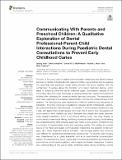Files in this item
Communicating with parents and preschool children : a qualitative exploration of dental professional-parent-child interactions during paediatric dental consultations to prevent early childhood caries
Item metadata
| dc.contributor.author | Yuan, Siyang | |
| dc.contributor.author | Humphris, Gerry | |
| dc.contributor.author | MacPherson, Lorna M. D. | |
| dc.contributor.author | Ross, Alistair L. | |
| dc.contributor.author | Freeman, Ruth | |
| dc.date.accessioned | 2021-05-27T16:30:10Z | |
| dc.date.available | 2021-05-27T16:30:10Z | |
| dc.date.issued | 2021-05-12 | |
| dc.identifier | 274387788 | |
| dc.identifier | a3da4d99-cc9d-4053-a453-1cd02bfaa93d | |
| dc.identifier | 85107203144 | |
| dc.identifier | 000654203900001 | |
| dc.identifier.citation | Yuan , S , Humphris , G , MacPherson , L M D , Ross , A L & Freeman , R 2021 , ' Communicating with parents and preschool children : a qualitative exploration of dental professional-parent-child interactions during paediatric dental consultations to prevent early childhood caries ' , Frontiers in Public Health , vol. 9 , 669395 . https://doi.org/10.3389/fpubh.2021.669395 | en |
| dc.identifier.issn | 2296-2565 | |
| dc.identifier.other | Jisc: b8d34c32243f443aae784da36a6ea6db | |
| dc.identifier.other | ORCID: /0000-0002-4601-8834/work/94669412 | |
| dc.identifier.uri | https://hdl.handle.net/10023/23266 | |
| dc.description | We would like to acknowledge funding for the Childsmile e-Health Project (Grant number: 803810) from the Scottish Government. | en |
| dc.description.abstract | The aim of this study was to explore communication interactions and identify phases adopted by dental professionals with parents and their young children and to examine the hypothesis that successful social talking between the actors together with the containment of worries allows the formation of a triadic treatment alliance, which leads to achieving preventive dental treatment goals. Conversation analysis of the transcribed data from video recordings of dental professionals, parents and preschool children when attending for preventive dental care was conducted. The transcriptions were read, examined and analysed independently to ensure the trustworthiness of the analysis. The transcriptions were explored for interactive patterns and sequences of interaction. Forty-four individual consultations between dental professionals, parents, and preschool children were recorded. The number of communication behaviours was 7,299, with appointment length ranging from 2 min 10 s to 29 min 18 s. Two patterns of communication were identified as dyadic (between two people) and triadic (between three people) interactions within a continuous shifting cycle. The three phases of communication were social talking, containing worries and task-focusing. Social talking was characterised by shifts between dyadic and triadic communication interactions and a symmetry of communication turns and containing worries. This typified the cyclical nature of the triadic and dyadic communication interactions, the adoption of talk-turn pairs, and triadic treatment alliance formation. Task-focusing pattern and structure were different for dentists and extended-duty dental nurses. For dentists, task-focusing was characterised by a dyadic interaction and as an asymmetrical communication pattern: for extended-duty dental nurses, task-focusing was typified by symmetrical and asymmetrical communication patterns within dyadic and triadic interactions. Empathy and understanding of the young child's emotional needs during containing worries allowed the formation of the triadic treatment alliance and with this treatment alliance, the acceptance of interventions to prevent early childhood caries during “task-focusing.” This qualitative exploration suggests that dyadic and triadic communication interactions are of a dynamic and cyclical quality and were exhibited during paediatric dental consultations. The communication phases of social talking, containing worries and task-focusing were evident. Successful social talking signalled the entry to containing worries and triadic treatment alliance formation which permitted the preventive goals of the consultation to be achieved (task-focusing). Future work should generate additional data to support the hypotheses created here namely that, social talking and containing worries triggers an integral pathway to task-focusing and the achievement of preventive dental goals. | |
| dc.format.extent | 13 | |
| dc.format.extent | 1021725 | |
| dc.language.iso | eng | |
| dc.relation.ispartof | Frontiers in Public Health | en |
| dc.subject | Public Health | en |
| dc.subject | Communication | en |
| dc.subject | Conversational analysis approach | en |
| dc.subject | Paedodontics | en |
| dc.subject | Dental professional | en |
| dc.subject | Parent | en |
| dc.subject | Pre-school child | en |
| dc.subject | Utterances | en |
| dc.subject | Cues | en |
| dc.subject | RJ101 Child Health. Child health services | en |
| dc.subject | RK Dentistry | en |
| dc.subject | E-DAS | en |
| dc.subject | SDG 3 - Good Health and Well-being | en |
| dc.subject.lcc | RJ101 | en |
| dc.subject.lcc | RK | en |
| dc.title | Communicating with parents and preschool children : a qualitative exploration of dental professional-parent-child interactions during paediatric dental consultations to prevent early childhood caries | en |
| dc.type | Journal article | en |
| dc.contributor.institution | University of St Andrews. Sir James Mackenzie Institute for Early Diagnosis | en |
| dc.contributor.institution | University of St Andrews. Population and Behavioural Science Division | en |
| dc.contributor.institution | University of St Andrews. WHO Collaborating Centre for International Child & Adolescent Health Policy | en |
| dc.contributor.institution | University of St Andrews. Health Psychology | en |
| dc.contributor.institution | University of St Andrews. St Andrews Sustainability Institute | en |
| dc.contributor.institution | University of St Andrews. School of Medicine | en |
| dc.identifier.doi | 10.3389/fpubh.2021.669395 | |
| dc.description.status | Peer reviewed | en |
This item appears in the following Collection(s)
Items in the St Andrews Research Repository are protected by copyright, with all rights reserved, unless otherwise indicated.

